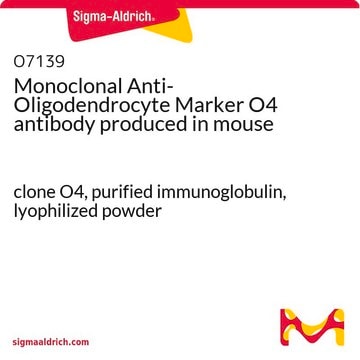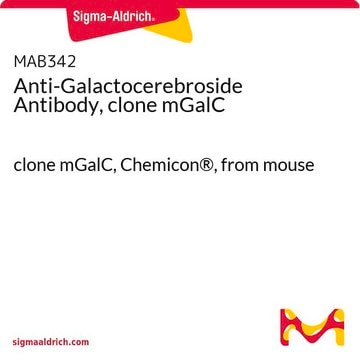MAB345M
Anti-O4 Antibody, clone 81
clone 81 (mAB O4), Chemicon®, from mouse
Synonim(y):
Sulfatide
About This Item
Polecane produkty
pochodzenie biologiczne
mouse
Poziom jakości
100
300
forma przeciwciała
purified immunoglobulin
rodzaj przeciwciała
primary antibodies
klon
81 (mAB O4), monoclonal
reaktywność gatunkowa
rat, mouse, human, chicken
producent / nazwa handlowa
Chemicon®
metody
immunocytochemistry: suitable
immunohistochemistry: suitable
izotyp
IgM
przydatność
not suitable for Western blot
not suitable for immunoprecipitation
Warunki transportu
wet ice
docelowa modyfikacja potranslacyjna
unmodified
Specyficzność
Zastosowanie
Immunocytochemistry: 10-20 μg/mL on cells fixed with 4% paraformaldehyde.
Note: O4 is a sulfatide, which can be dissolved out of the membrane by organic solvents; acetone and methanol should not be used for fixation.
Optimal working dilutions must be determined by the end user.
Immunohistochemistry protocol
1. Prepare sections from unfixed, shock frozen tissue. The sections should be 4-5 μm thick. Place the sections on microscope slides.
2. Wash the slide three times for 5 min. each in PBS at room temperature.
3. Block the non-specific binding sites by incubating the sections in a humid chamber with 5% FCS at room temperature for 30 minutes.
4. Wash the slides as described in step 2.
5. Cover the sections with a sufficient amount of MAB345 (10-20 μg/mL in PBS) and incubate in a humid chamber at 37°C for one hour.
6. Wash the slides briefly three times with PBS. Carefully dry around the area to be stained.
7. Cover the sections with a sufficient amount of anti-mouse IgM-fluorescein* solution and incubate in a humid chamber at 37°C for one hour.
8. Wash the slides as described in step 6.
9. Cover the sections with a suitable embedding medium, cover with a cover slip, and examine by fluorescence microscopy.
*HRP or ABC can also be used.
Optimal results can be obtained by titrating the primary and secondary antibodies
Immunocytochemistry
1. Fix the preparations with 4% paraformaldehyde (in PBS) at room temperature for 10 minutes. O4 is a sulfatide which can be dissolved out of the membrane by organic solvents; acetone and methanol should not be used for fixation.
2. Wash the slide three times for 5 min. each in PBS at room temperature.
3. Block the non-specific binding sites by incubating the sections in a human chamber with 5% FCS at room temperature for 30 minutes.
4. Wash the slides as described in step 2.
5. Cover the sections with a sufficient amount of MAB345 (10-20 μg/mL in PBS) and incubate in a humid chamber at 37°C for one hour.
6. Wash the slides briefly three times with PBS. Carefully dry around the area to be stained.
7. Cover the sections with a sufficient amount of anti-mouse IgM-fluorescein solution and incubate in a humid chamber at 37°C for one hour.
8. Wash the slides as described in step 6.
9. Cover the sections with a suitable embedding medium, cover with a cover slip, and examine by fluorescence microscopy.
Note: Do not allow the preparations to dry out during staining.
Postać fizyczna
Komentarz do analizy
Rat cortical stem cells or day 3 cell cultures of brains from mouse embryos
Inne uwagi
Informacje prawne
Nie możesz znaleźć właściwego produktu?
Wypróbuj nasz Narzędzie selektora produktów.
Kod klasy składowania
10 - Combustible liquids
Klasa zagrożenia wodnego (WGK)
WGK 2
Certyfikaty analizy (CoA)
Poszukaj Certyfikaty analizy (CoA), wpisując numer partii/serii produktów. Numery serii i partii można znaleźć na etykiecie produktu po słowach „seria” lub „partia”.
Masz już ten produkt?
Dokumenty związane z niedawno zakupionymi produktami zostały zamieszczone w Bibliotece dokumentów.
Nasz zespół naukowców ma doświadczenie we wszystkich obszarach badań, w tym w naukach przyrodniczych, materiałoznawstwie, syntezie chemicznej, chromatografii, analityce i wielu innych dziedzinach.
Skontaktuj się z zespołem ds. pomocy technicznej








